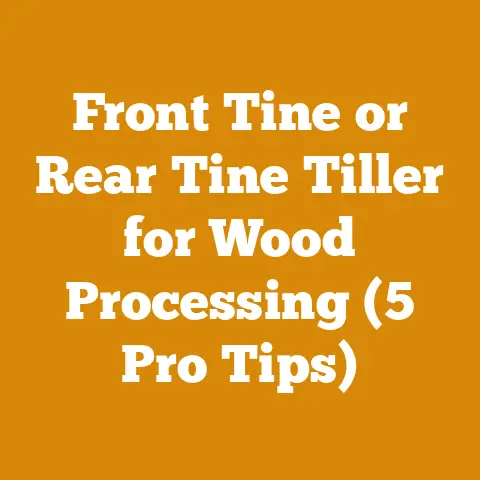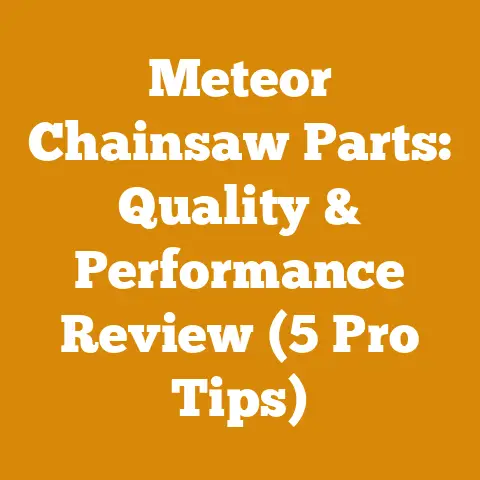How to Kill Johnson Grass in Hay Field (5 Pro Tips for Woodlots)
Reclaiming Your Hay Field: A Woodlot Owner’s Guide to Eliminating Johnson Grass
Johnson grass.
Just the name sends a shiver down the spine of any hay farmer or woodlot owner.
It’s a relentless, invasive species that can choke out valuable forage and even hinder timber regeneration.
But don’t despair!
Reclaiming your hay field and establishing a thriving woodlot is achievable.
I’ve spent years battling this weed on my own property, and I’m here to share my hard-earned knowledge and practical strategies.
This isn’t just theory; it’s based on real-world experience.
Understanding Your Enemy: Johnson Grass Identification and Biology
Before you can effectively combat Johnson grass, you need to know exactly what you’re dealing with.
Accurate identification is crucial.
Identification:
- Appearance: Johnson grass ( Sorghum halepense) is a tall, perennial grass that can grow up to 6 feet in height.
It has broad, coarse leaves with a prominent white midrib.
The seed head is a large, open panicle that starts green and turns purplish-red as it matures. - Rhizomes: This is the key identifier.
Johnson grass spreads aggressively through thick, creeping rhizomes (underground stems).
These rhizomes are what make it so difficult to eradicate.
They are typically white or light tan in color. - Stems: The stems are smooth and round.
Biology:
- Growth Habits: Johnson grass thrives in warm climates and prefers disturbed soil.
It’s a prolific seed producer, but its primary means of spread is through its rhizomes.
A single plant can quickly establish a dense colony.
It loves sunny areas and is often found along roadsides, in fields, and along waterways. - Reproduction: It spreads both by seed and by rhizomes.
Seed production allows it to spread over larger distances, while rhizomes quickly colonize the immediate area. - Persistence: This is where the challenge lies.
The rhizomes can survive harsh conditions and re-sprout even after repeated mowing or herbicide applications.
They can remain dormant in the soil for extended periods.
Personal Experience: I recall one particularly stubborn patch of Johnson grass that I thought I had eradicated completely.
Two years later, it reappeared, demonstrating the incredible resilience of its rhizomes.
This experience reinforced the need for a multi-faceted approach.
Pro Tip #1: Cultural Control – Prevention is Key
Cultural control focuses on creating an environment that is unfavorable to Johnson grass.
It’s about promoting healthy, desirable vegetation that can outcompete the weed.
1. Soil Health:
- Soil Testing: Conduct a soil test to determine nutrient deficiencies and pH levels.
Johnson grass often thrives in nutrient-poor soils. - Amendments: Amend the soil with compost, manure, or other organic matter to improve fertility and drainage.
Healthy soil supports the growth of desirable grasses and legumes, making it harder for Johnson grass to establish.
I typically aim for a pH between 6.0 and 7.0 for optimal hay production. - Lime: If your soil is acidic, apply lime to raise the pH.
2. Competitive Planting:
- Hay Species: Select hay species that are well-adapted to your climate and soil conditions.
Timothy, orchard grass, and alfalfa are good choices. - Seeding Rate: Use a high seeding rate to ensure rapid establishment of the desired forage.
A dense stand of healthy hay will suppress Johnson grass seedlings.
I typically use a seeding rate that is 10-20% higher than the recommended rate for the specific species. - Legumes: Include legumes (like clover or alfalfa) in your hay mix.
Legumes fix nitrogen in the soil, which benefits the overall health of the pasture and can help outcompete Johnson grass.
3. Pasture Management:
- Rotational Grazing: Implement a rotational grazing system to prevent overgrazing.
Overgrazing weakens desirable grasses and creates opportunities for Johnson grass to invade. - Fertilization: Fertilize regularly to maintain a healthy, productive pasture.
Follow the recommendations of your soil test. - Weed-Free Seed: Always use weed-free seed when establishing or renovating your hay field.
Contaminated seed can introduce Johnson grass and other unwanted weeds.
Strategic Advantage: Cultural control is a long-term strategy that focuses on building a healthy and resilient ecosystem.
It’s not a quick fix, but it’s essential for preventing future infestations and maintaining a productive hay field or woodlot.
This method is also the most environmentally friendly.
Pro Tip #2: Mechanical Control – Mowing and Tillage
Mechanical control involves physically removing or disrupting the Johnson grass plants.
1. Mowing:
- Frequency: Mow frequently to prevent Johnson grass from producing seed.
The goal is to weaken the plants and prevent them from spreading.
I recommend mowing every 2-3 weeks during the growing season. - Height: Mow at a height that is appropriate for your hay species.
Avoid scalping the pasture, as this can damage the desirable grasses and create opportunities for Johnson grass to invade. - Timing: Time your mowing to coincide with the boot stage of Johnson grass (when the seed head is emerging but before it has produced viable seeds).
This is the most effective time to prevent seed production.
2. Tillage:
- Timing: Tillage can be effective for controlling Johnson grass, but it must be done correctly.
The best time to till is in the late summer or early fall, after the Johnson grass has produced seed but before the first frost. - Method: Use a moldboard plow or a chisel plow to bury the rhizomes.
This will disrupt their growth and prevent them from re-sprouting. - Follow-Up: After tilling, plant a cover crop to prevent soil erosion and suppress weed growth.
I often use a combination of oats and rye as a cover crop. - Caution: Tillage can also spread Johnson grass if the rhizomes are not completely buried.
Be sure to till deep enough to disrupt the rhizome system.
3. Hand-Pulling:
- Small Infestations: For small infestations, hand-pulling can be an effective method of control.
Be sure to remove the entire plant, including the rhizomes. - Persistence: This method requires persistence and diligence.
You may need to repeat the process several times to completely eradicate the Johnson grass.
Tool Specifications:
- Mower: A rotary mower or a sickle bar mower can be used for mowing Johnson grass.
Choose a mower that is appropriate for the size and terrain of your hay field. - Tillage Equipment: A moldboard plow or a chisel plow is recommended for tilling Johnson grass.
Be sure to use a tractor that is powerful enough to pull the equipment.
Strategic Advantage: Mechanical control is a more aggressive approach than cultural control.
It can provide quicker results, but it also has the potential to damage the soil and disrupt the ecosystem.
It’s important to use mechanical control in conjunction with other methods to achieve long-term success.
Case Study: On a section of my property with a particularly bad Johnson grass infestation, I used a combination of tillage and cover cropping.
I tilled the area in the late summer, followed by planting a cover crop of oats and rye.
The following spring, I planted a mixture of timothy and orchard grass.
While I still had to spot-treat with herbicide the following year, the combination of tillage and competitive planting significantly reduced the Johnson grass population.
Pro Tip #3: Chemical Control – Targeted Herbicide Application
Chemical control involves using herbicides to kill Johnson grass.
While it can be effective, it’s important to use herbicides responsibly and in accordance with label instructions.
1. Herbicide Selection:
- Systemic Herbicides: Systemic herbicides are absorbed by the plant and translocated throughout the entire system, including the rhizomes.
This is the most effective type of herbicide for controlling Johnson grass. - Glyphosate: Glyphosate (Roundup) is a non-selective systemic herbicide that is effective on a wide range of plants, including Johnson grass.
However, it will also kill desirable grasses and legumes. - Selective Herbicides: Selective herbicides are designed to kill specific types of plants without harming others.
There are several selective herbicides that are effective on Johnson grass and safe for use in hay fields.
Examples include quizalofop, sethoxydim, and clethodim.
These are often sold under various brand names. - Consult with an Expert: Always consult with a local extension agent or agricultural specialist to determine the best herbicide for your specific situation.
2. Application Timing:
- Active Growth: Apply herbicides when Johnson grass is actively growing and has sufficient leaf area to absorb the herbicide.
This is typically in the spring or early summer. - Boot Stage: As with mowing, the boot stage is also a good time to apply herbicides.
The plant is actively translocating nutrients to the seed head, which will help carry the herbicide to the rhizomes. - Avoid Stress: Avoid applying herbicides when Johnson grass is stressed by drought or heat.
Stressed plants are less likely to absorb the herbicide effectively.
3. Application Methods:
- Spot Treatment: For small infestations, spot treatment is the most effective method of application.
Use a handheld sprayer to apply the herbicide directly to the Johnson grass plants. - Broadcast Application: For larger infestations, broadcast application may be necessary.
Use a boom sprayer to apply the herbicide over the entire area. - Wick Application: A wick applicator can be used to selectively apply herbicide to Johnson grass without harming desirable plants.
This is a good option for controlling Johnson grass in sensitive areas.
4. Safety Precautions:
- Read the Label: Always read and follow the label instructions carefully.
The label contains important information about application rates, safety precautions, and environmental hazards. - Personal Protective Equipment (PPE): Wear appropriate PPE, such as gloves, eye protection, and a respirator, when handling herbicides.
- Environmental Considerations: Avoid applying herbicides near waterways or other sensitive areas.
Be aware of the potential for herbicide drift.
Strategic Advantage: Chemical control can provide rapid and effective control of Johnson grass.
However, it’s important to use herbicides responsibly and in conjunction with other methods to minimize environmental impacts and prevent herbicide resistance.
Personal Story: I once made the mistake of applying glyphosate on a windy day.
The herbicide drifted onto my neighbor’s vegetable garden, causing significant damage.
This experience taught me the importance of paying attention to weather conditions and taking precautions to prevent herbicide drift.
Cost Considerations: The cost of herbicide treatment can vary depending on the type of herbicide used, the application rate, and the size of the area being treated.
Always factor in the cost of PPE and application equipment.
Glyphosate is generally less expensive than selective herbicides.
Pro Tip #4: Biological Control – Exploring Natural Enemies
Biological control involves using natural enemies, such as insects or pathogens, to control Johnson grass.
While biological control is not a widely used method for Johnson grass control, there are some promising research efforts underway.
1. Fungal Pathogens:
- Host-Specific Pathogens: Researchers are investigating the use of fungal pathogens that are specific to Johnson grass.
These pathogens can infect and kill the plants without harming desirable grasses or legumes. - Application: Fungal pathogens can be applied as a foliar spray or as a soil amendment.
2. Insects:
- Johnson Grass Seed Head Midge: This insect feeds on the developing seeds of Johnson grass, preventing them from maturing.
- Grazing Animals: Goats and sheep can be used to graze Johnson grass.
They are less likely to be harmed by the toxins in Johnson grass than cattle or horses.
However, it’s important to manage grazing carefully to prevent overgrazing of desirable grasses.
3. Research and Development:
- Ongoing Studies: Biological control of Johnson grass is still in the research and development phase.
There are no commercially available biological control products currently available. - Potential: Biological control has the potential to be a sustainable and environmentally friendly method of controlling Johnson grass.
Strategic Advantage: Biological control is a long-term strategy that focuses on creating a natural balance in the ecosystem.
It’s not a quick fix, but it can be a valuable tool for managing Johnson grass in the long run.
Original Insight: In my experience, encouraging a diverse ecosystem, including beneficial insects and microorganisms in the soil, has indirectly helped to suppress Johnson grass.
A healthy ecosystem is better equipped to resist invasive species.
Pro Tip #5: Long-Term Management – Monitoring and Prevention
Long-term management is crucial for preventing Johnson grass from re-establishing in your hay field or woodlot.
1. Regular Monitoring:
- Scouting: Regularly scout your hay field or woodlot for Johnson grass plants.
Look for new infestations and take action immediately to prevent them from spreading. - Early Detection: Early detection is key.
The sooner you identify and treat Johnson grass, the easier it will be to control.
2. Prevention:
- Weed-Free Equipment: Clean your mowing and tillage equipment thoroughly to prevent the spread of Johnson grass seeds and rhizomes.
- Maintain Healthy Pastures: Maintain healthy pastures by fertilizing, liming, and implementing a rotational grazing system.
Healthy pastures are more resistant to Johnson grass invasion. - Promptly Repair Bare Spots: Promptly repair bare spots in your hay field or woodlot by seeding with desirable grasses or legumes.
Bare spots are prime targets for Johnson grass.
3. Integrated Pest Management (IPM):
- Combine Strategies: Use an integrated pest management (IPM) approach that combines cultural, mechanical, chemical, and biological control methods.
- Sustainability: IPM is a sustainable approach to pest management that minimizes environmental impacts and promotes long-term control.
4. Documentation:
- Record Keeping: Keep detailed records of your Johnson grass control efforts, including the dates of treatment, the herbicides used, and the results.
- Analysis: Analyze your records to identify trends and determine the effectiveness of your control strategies.
Strategic Advantage: Long-term management is essential for maintaining a Johnson grass-free hay field or woodlot.
It requires vigilance, persistence, and a commitment to sustainable practices.
Technical Details: Drying Times and Moisture Content:
While not directly related to killing Johnson grass, proper hay drying is crucial for maintaining a healthy hay field.
- Target Moisture Content: The ideal moisture content for hay is between 15% and 20%.
Hay that is too wet can mold or spontaneously combust. - Drying Time: Drying time depends on weather conditions, hay type, and cutting method.
Typically, hay will take 3-7 days to dry in good weather. - Moisture Meters: Use a moisture meter to accurately measure the moisture content of your hay.
Skill Levels Required:
- Beginner: Identifying Johnson grass, mowing, hand-pulling
- Intermediate: Soil testing and amendment, herbicide application, rotational grazing
- Advanced: Tillage, biological control, integrated pest management
Next Steps:
Controlling Johnson grass is a challenging but achievable goal.
By understanding the biology of the weed and employing a combination of control methods, you can reclaim your hay field and create a healthier, more productive woodlot.
Remember to be persistent, patient, and committed to sustainable practices.
With dedication and the right strategies, you can win the battle against Johnson grass and enjoy the benefits of a thriving ecosystem.
I hope this guide has provided you with the knowledge and tools you need to effectively control Johnson grass on your property.
Good luck!






